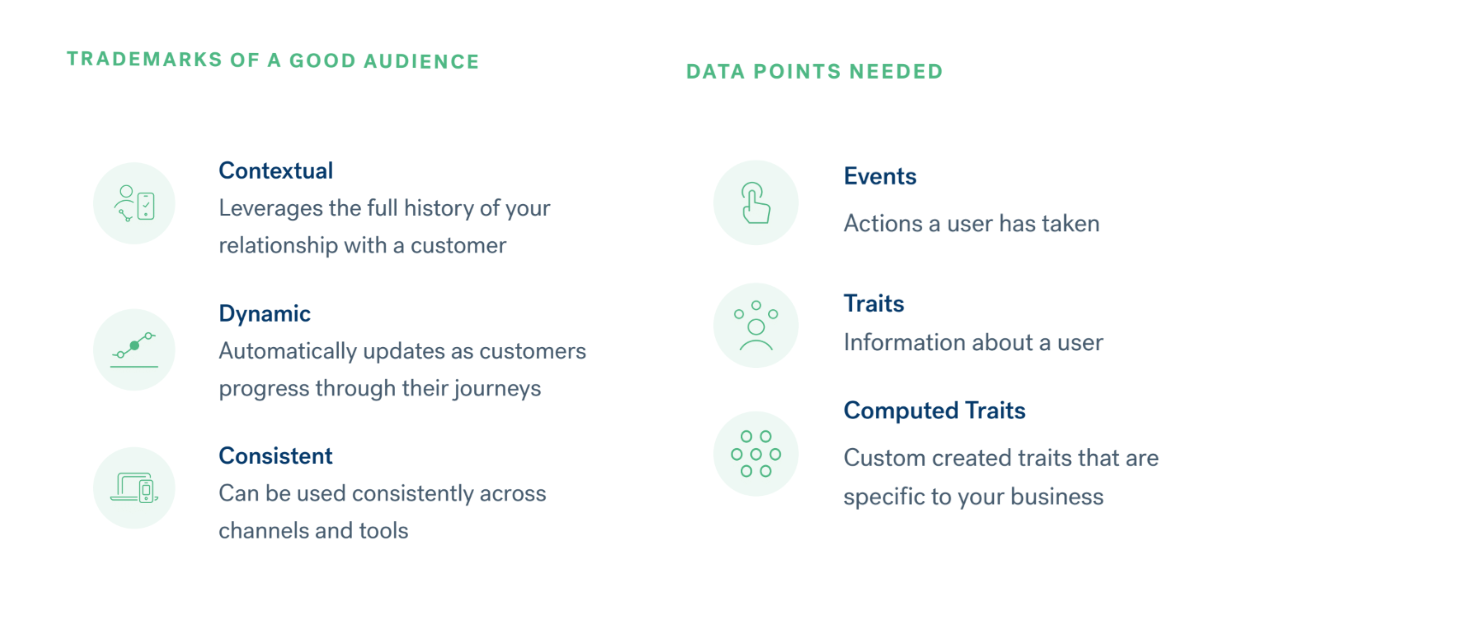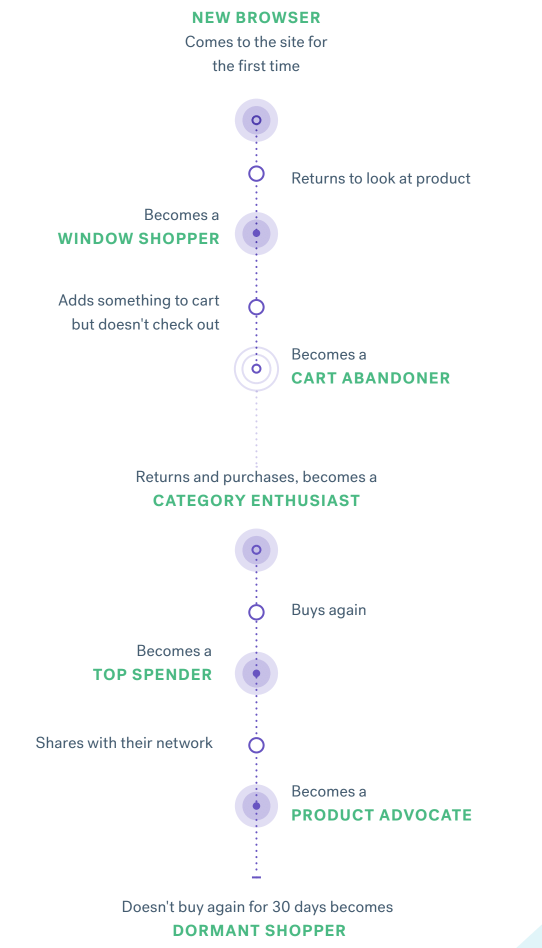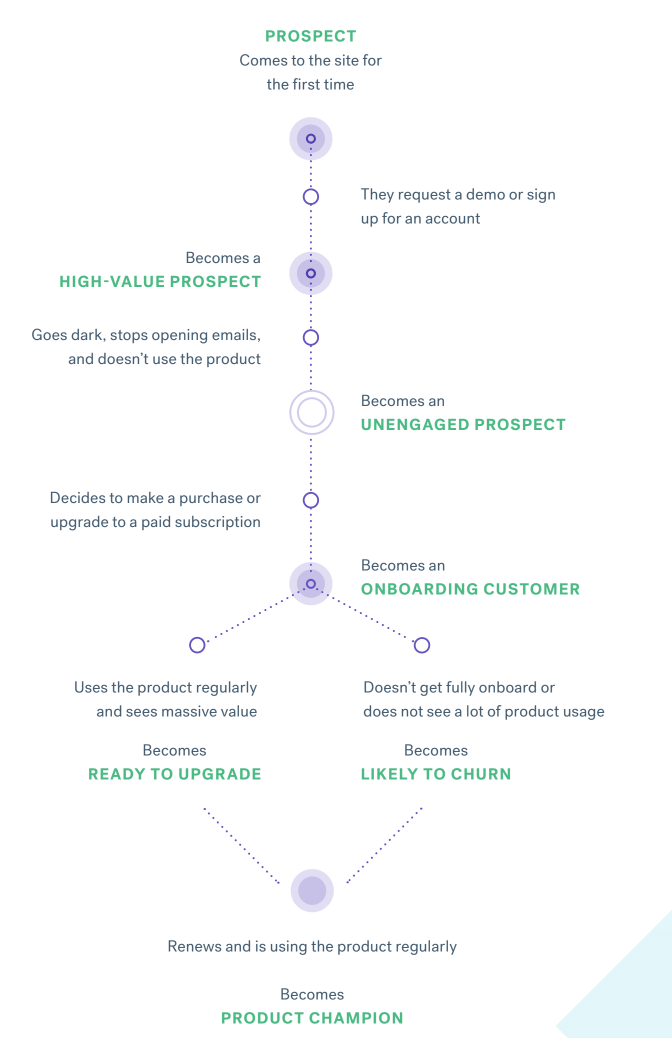Marketers — or anyone tasked with engaging their customers — create audience segments to deliver personalized, relevant messages at scale. Targeting specific user segments, rather than sending all of your users that same message, improves customer experiences, engagement, and campaign outcomes. However, not all audience segments are created equally.
Qualities of good audience segments
Have you ever received a message from a company and just thought, "Damn, how did they know!?" That's a pretty good feeling.
What about the opposite? What's your reaction when you get a message for something that's completely unrelated to your life or doesn't take into account your history with a company. That feels… less good.
For the companies responsible for sending those messages — we're looking at you!! — it's all about how you create your audiences! The best audience segments are shared across channels because customers expect a cohesive experience no matter where they engage with your brand. If you build segments in each end-tool your team uses, they can easily get out of sync and create a disjointed customer experience. Therefore, the best way to deliver a consistent experience is to build your audience segments where your data originates and federate them out to all of your channels.
In addition, behavior-based data, even more so than demographic data, gives you the most helpful information for developing audiences and relevant messages for those audience segments. Behavior-based data focuses on how a customer has actually interacted with your company rather than relying on stereotypes of what their demographic group should like. It's not enough to know just what a customer has done recently. Effective audience segments also take into account a customer's historical context with your brand and automatically updates as your relationship with a customer evolves. For example, just because a user purchased a toilet seat cover most recently, it doesn't mean that it's their favorite product and that you should send them messages or ads about it.

Create richer audiences with your existing customer analytics
At this point in your Analytics Academy journey, there's no doubt that you have established analytics to understand your customer journey. Or, have at least started planning what those analytics could look like. The same behavioral, or event, data that your you'll use to record with analytics can also be used to build audiences. Hooray!
For example, once you have the events implemented, you could create an audience of users that have signed up for a newsletter and viewed a product page. Or, in a more advanced use case, you could use a BI tool — or Segment's Personas product — to create an audience of shoe fanatics that have opened emails at least three times but have not made a purchase in the last 30 days.
Events and properties are the building blocks for these audiences. Here are a few common events that our e-commerce customers use for building audiences.
Product ViewedPromotion ClickedProduct Added to CartCart ViewedOrder Completed
To give these data points more color, most events have associated properties that explain more about the interaction. For example, a Product Viewed event could include properties like the category, brand, and price.
Products Viewedcategorybrandpriceproduct_idname
These properties are helpful for creating custom customer attributes. For instance, you can compute the most_frequent_category_viewed for a customer. These computations are based on your events and the event properties that you are tracking. They can be sums, aggregates, or the first/last time something occurred.
The best audiences to get started with for B2C
We've identified the top commonly used B2C/e-commerce customer segments that follow a new user's journey with your brand. From the first time an anonymous visitor views a product on your website or app, to when they add it to the cart, to when they purchase it, and then come back time and time again (hopefully), you can automate campaigns to make sure you are optimizing for both the customer experience and your business value.

New browsers
Newly acquired users that haven't made a purchase are at a very high risk of churning. While they may have downloaded your app or signed up for an account, they're likely not invested in your brand or products. (Yet!) According to Amplitude, e-commerce apps lose up to 80% of their newly acquired users in just three days. For e-commerce companies, progressing these users through the onboarding process and toward their first purchase is the top priority.
Recommended campaign examples:
Notify the steps left to complete account setup
Promote 20% off first purchase/first month subscription
Window shoppers This is a group of customers who are on the fence about buying. They have browsed multiple times but not completed a purchase. They have also recently engaged with an email marketing campaign. Similar to cart abandoners, this group has a very high likelihood of converting with the right motivation.
Recommended campaign examples:
Promote limited time sale (e.g., weekend sale)
Highlight new styles available for favorite category
Retarget on social channels of recently viewed items
Cart abandoners
Cart abandoners are customers that have added an item to the cart but have not completed their order. This is a very valuable group of users for e-commerce companies because they have displayed a clear intent to buy but, for some reason, did not complete their purchases. Timing is essential for cart abandonment campaigns. Follow up too soon, and you may actually interrupt the customer's purchase flow. Follow up too late, and you may lose them completely.
Recommended campaign examples:
Reminder that items are still left in their shopping cart
Promote 20% off orders completed in the next two hours
Recommend abandoned items during next shopping session
Category enthusiasts Similar to your Top Spenders, this is a loyal group of customers. Typically, they have one or two favorite product categories or items that they buy repeatedly. Knowing what those product categories are over the customer's entire relationship with your brand gives you the ability to drive higher engagement. You can cater your messages or ads to the specific user and highlight new products or services that will interest them.
Recommended campaign examples:
Highlight new styles in their favorite category
Offer a small discount in their favorite category
Exclude recent purchasers from retargeting lists
Top spenders
On average, loyal customers are worth up to 10x as much as their first purchase. They purchase regularly and are the top 5-10% of your customer base in terms of sales value. This group is also commonly referred to as high LTV customers. While they don't need big financial incentives, you'll want to deliver campaigns aimed at them to maintain their engagement.
Recommended campaign examples:
Promote free shipping on orders over $100
Refer a friend for a credit that they can apply to their next purchase
Develop lookalike campaigns to attract more big spenders
Product advocates
This is your group of engaged shoppers or social media experts. They are influencers and will share their favorite product or experiences with their network. This is the ideal customer segment to engage for ratings and reviews.
Recommended campaign examples:
Create campaigns to encourage a review of their most recent purchase
Refer a friend for a credit that they can apply to their next purchase
Dormant shoppers
Dormant shoppers are customers that you haven't seen in a while. This group of customers have made purchases in the past but have not made any purchases recently. Typically this purchase gap is between 30-90 days, depending on your business and the frequency at which customers purchase. It is especially important to pursue these customers with additional emails or advertisements so they don't churn for good.
Recommended campaign examples:
Create a re-engagement campaign with personalized offer
Highlight new products in their favorite or last purchased category
The best audiences to get started with for B2B
It's only fair. We gave some examples of the audiences B2C companies should be using, now it's time for the B2B ones.
These audiences are also based around a new customer. From the first time an anonymous visitor views a page on your website or app, to when they sign up for an account, and then come back time and time again.

High value prospects
High value prospects are accounts in the sales funnel that deserve close attention. Depending on your company, these prospective accounts will be companies that are a certain size or are in a specific set of industries that have recently signed up for an account or requested a demo. Another indication that a prospect is high value is their likelihood to convert. If one or more people at the account have displayed high intent signals — for example viewing the pricing page or logging in to a trial account multiple times — then it's far more likely that they'll be interested in hearing from your sales team.
Recommended campaign examples:
Trigger live chat to initiate a sales conversation
Set up time for a personalized demo
Highlight similar companies and their use cases
Unengaged prospects
This is a group of prospects that were at one point engaged in the sales cycle but are now showing signs that they will not convert. They may have not logged in, failed to complete the onboarding process, or stopped opening emails. Any combination of these signs means that your team should take steps to intervene.
Recommended campaign examples:
Notification that the prospect can extend their trial
Campaign that highlights five tips for getting the most out of the product
Personal email with a relevant case study
Discount of 10% off their first month's subscription
Onboarding customers
The first days or weeks of a customer relationship are critical toward driving customer satisfaction and reducing churn. Once a customer is successfully onboarded, they can start seeing value in your product. Then, they are much more likely to use it, advocate for it internally, and renew when the time comes.
Recommended campaign examples:
Welcome email with first steps that a customer needs to take
Campaign that highlights five tips for getting the most out of the product
Highlight helpful documentation or a step-by-step implementation guide
Ready to upgrade
Without the right data, gauging a current customer's willingness to upgrade to a larger contract can be difficult, manual work. However, if you can track the right signals, it becomes much easier to determine if they're demonstrating digital buying signs. Depending on your company, this audience could contain users or accounts who have frequently viewed the pricing page, engaged with a recent ad campaign, or exceeded their monthly plan limits.
Recommended campaign examples:
Highlight the benefits of a higher tier plan
Notification that an account is over their allotted usage with their current plan
Customers likely to churn
Even the best B2B companies lose customers. Research shows that a majority of SaaS companies lose up to 10% of their customer annually. However, the less you lose, the more revenue you keep. Churn risks are a group of accounts that need immediate attention from your team. There are many signs that could indicate that a customers is likely to churn. Some key signs to keep a close eye on are product usage, email engagement, NPS, and the number of support tickets a customer has submitted.
Recommended campaign examples:
New feature highlights
Re-engagement campaign
Product champions
Product champions are your power users within each account. For each company that you work with, your product champion will be the user that has logged in most frequently over a certain time period. This segment is especially valuable because they are, more often than not, going to be the people you rely on when you need beta participants, product feedback, and have time-sensitive communications for a specific account.
Recommended campaign examples:
Invitation to local customer events
Preview of a new product or service
Beta product recruitment
Notification of potential account issues
The importance of audience customization and flexibility
While these audiences are helpful for all companies in some form, yours might differ slightly based on your products and customer-base.
For example, on-demand companies like Instacart will have a much shorter intent window than an online car retailer like DGDG.com. These two companies will have a tremendous difference in average order value and order frequency for customers.
On the B2B side, companies that require annual contracts will have a much longer sales cycle and higher deal size than a company that allows for monthly or pay-as-you-go subscriptions. Both will have very different customer journeys and will require different campaigns to keep their users moving in the right direction.
Net-net: Understanding your customers — using analytics — will help you create better audiences. Well, isn't that just delightfully full circle.